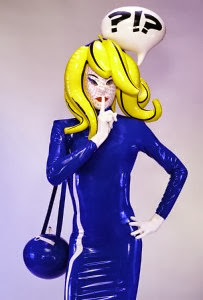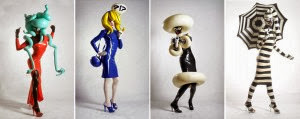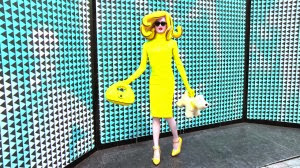LIVING POP ART: PANDEMONIA
By: Laura Collinson
Origional article: To Be Continued Magazine
Unless you’ve been hiding under a rock for the past year, you’ll have seen Pandemonia. Since her emergence onto the fashion scene in 2007, Pandemonia has attracted attention across the globe- mostly the attention of confused onlookers who are quite unsure as to whether they’re hallucinating or not. People can’t really be blamed for gawping though, at seven foot tall and completely fashioned from latex, Pandemonia is quite something.
The question that has come from those who have come into contact with Pandemonia runs along the lines of ‘just who is under that suit?’ The answer is simple, no one knows. When asked whether the artist beneath hangs out with celebrities when not dressed as Pandemonia, the answer was frank, ‘I’m Pandemonia all the time.’
As with anyone in the public eye, there has been much speculation to Pandemonia’s past. Her occupation is artist, and Pandemonia herself is a piece of performance art. The idea for Pandemonia was ‘a gradual process’, a response to popular culture. ‘Over the last decade many things have happened. The rise of celebrity, Big Brother, free newspapers, social media, technology, the financial crisis; winner takes all culture’, however it wasn’t until later that the idea was conceived, ‘the idea for Pandemonia came to me on a bus to the airport but the name came a little later.’
And so Pandemonia came to be; almost. ‘At first there was no name. I was interested in using myths and tapping into the collective subconscious. The idea was to create a media person and show the work through the media, a bit like a Shakespearian play within a play. The name Pandemonia got locked down because of the invites. To be invited one has to have a name. The name came in 2007, so you could say that was the birth of Pandemonia.’
The birth of Pandemonia sent the fashion world into frenzy. Of course, the industry is no stranger to outlandish outfits and unlikely celebrities, but Pandemonia made Leigh Bowery look understated in comparison. When asked to name her favourite celebrity event attended so far, Pandemonia pinpointed the Felder & Felder show in February due to her presence being documented so extensively that it became ‘a story’, ‘with a beginning a middle and an end.’
Fashion also plays a huge part in the work of Pandemonia. The latex outfits are designed specifically and draw great influence from the seasonal trends. Pandemonia states the last piece that she designed as the favourite outfit- a red dress with yellow accessories to match the bouffant blonde hair. ‘The strong colour combination made it visually pop.’ The recent addition of a fringe is also a link in to the current trends, and Pandemonia describes it as, ‘my strongest hair style to date.’
In terms of wider influence, Pandemonia lists the media as number one as it’s where today’s stories and myths are created. She also discusses the merits of social media as a platform to be seen, ‘the old analogue media no longer has the right to censorship- they can no longer control what is being said.’ There is also the factoring in of anonymity that Pandemonia believes gives ‘a certain freedom’. The idea of the anonymous commentator is no new thing, as Pandemonia admits, harking back to the time of Charlotte Brontë and George Eliot- ‘They also used noms de plume to get their work and ideas heard.’
Although Pandemonia very much seems one on her own, the concept draws inspiration from other contemporary artists. The paparazzi photographer Ron Galella is named as one of Pandemonia’s biggest influences. ‘He portrayed a revolving cast of famous faces. We are all joined by knowing these faces and are able to participate in their story.’ However, having said this, Pandemonia also states that she doesn’t tend to look at other contemporary artists too much because she doesn’t want to be influenced by others- ‘I try and follow my own line of thought.’
Bruce McLean is one of the only conceptual artists that Pandemonia names as someone she admires- ‘that might sound like a strange choice. The thing I like about Bruce’s work is it was so un-art, so un-hallowed’, she adds, ‘He was this bloke that was posing on a plinth.’ At this point Pandemonia raises the important point that art doesn’t necessarily have to be ‘about dripping paint or installations’. Pandemonia is living, breathing proof that art can be much more than this.
Although people may never know who is behind the glamorous, latex outfits, one thing is for sure: Pandemonia may have inflatable hair but she’s in no way an airhead. The research that has gone into creating a walking work of art is extensive, as is the attention to detail that goes into every outfit, not to mention Pandemonia’s pet dog Snowy. In an age of celebritisation and the ever imposing Orwellian themes of the 21st century, Pandemonia seems in every way the perfect mascot for 2013.
‘I have managed to create a myth and show my work to a global audience. I am followed from China to Chile, America to Russia, and Australia to the UK. I’ve been in a broad cross-section of magazines and newspapers. In their issue on London, Harper’s Bazaar China wanted one designer and one artist to represent London. They chose Vivienne Westwood and Pandemonia.’ Case rested. Laura Collinson




